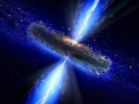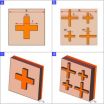(Press-News.org) ARLINGTON, Va. — Designed to cut the 50 pounds of battery devices hauled by the Navy's explosive ordnance disposal (EOD) teams, the Office of Naval Research's (ONR) TechSolutions Program has developed a lightweight power system, which was delivered July. 22.
Responding to a request from the Explosive Ordnance Disposal Training and Evaluation Unit (EODTEU) 2 to create a lightweight power device to charge their specialized equipment, TechSolutions partnered with Naval Surface Warfare Center Crane, Ind., and Protonex Technology Corp. to develop the Power Management Kit (PMK) and shipped five units to the team for a trial.
"The PMK gives the warfighter a very significant weight reduction in batteries, chargers and adapters, while also increasing real-time awareness of power usage and availability," said Phil Robinson, Protonex's vice president and ONR's principal investigator for the PMK project.
The kit is a lightweight, portable system containing common military rechargeable batteries, a solar-powered blanket, a 1-pound Soldier Power Manager (SPM) unit and "smart" cables to link the SPM with EOD equipment. The PMK is centered around the SPM, which can harness energy from a variety of sources to charge batteries and provide power to attached gear. Any new equipment added to the EOD team's arsenal can be supported by merely providing a new cable. Therefore, the SPM itself never requires an upgrade.
By enabling teams to use alternative energy sources, such as a solar cell-covered blankets and fuel cells, the PMK reduces the team's logistics footprint. Few of the Navy's EOD teams' primary tools and equipment use the same power sources, so Sailors and Marines must carry multiple single-purpose batteries to power their gear.
"Currently, if one were to collect all the battery chargers allocated to an EOD platoon, they would fill a 4-foot by 4-foot table," according to EODTEU 2 Combat Development staff. "The PMK, with all of its cables, and the SPM in a soft roll case weigh only 9 pounds, replacing up to 50 pounds of specialized chargers and related equipment."
A graphical interface displays information about batteries and sources, power usage, state of charge and operational details. This data is stored and analyzed, providing EOD teams with unprecedented visibility, safety, situational awareness and readiness when planning future missions.
TechSolutions accepts recommendations and suggestions from Navy and Marine Corps personnel on ways to improve mission effectiveness through the application of new technology. The TechSolutions team provides Sailors and Marines with prototype technologies to rapidly address immediate needs. TechSolutions works closely with the fleet and force to meet specific requirements that cannot be readily satisfied with commercial off-the-shelf technologies. Typical turn-around time for a working prototype is 12-18 months.
INFORMATION:
For more information about TechSolutions or to submit a request, Sailors and Marines can visit the TechSolutions website at https://www.onr.navy.mil/techsolutions or e-mail ideas to techsolutions@onr.navy.mil.
About the Office of Naval Research
The Department of the Navy's Office of Naval Research (ONR) provides the science and technology necessary to maintain the Navy and Marine Corps' technological advantage. Through its affiliates, ONR is a leader in science and technology with engagement in 50 states, 70 countries, 1,035 institutions of higher learning and 914 industry partners. ONR employs approximately 1,400 people, comprising uniformed, civilian and contract personnel, with additional employees at the Naval Research Lab in Washington, D.C.
Office of Naval Research's TechSolutions program lightens burden for Navy's EOD team
Organization develops lightweight, plug-and-play portable power system
2011-07-25
ELSE PRESS RELEASES FROM THIS DATE:
Deepwater Horizon crude less toxic to bird eggs after weathering at sea
2011-07-25
After collecting weathered crude oil from the Gulf of Mexico following the Deepwater Horizon oil spill, researchers at The Institute of Environmental and Human Health (TIEHH) at Texas Tech University have reported that only 8 to 9 percent coverage on the shells of fertilized mallard duck eggs resulted in a 50 percent mortality rate.
However, scientists also reported the amount of time the oil remained at sea and exposed to weather had a significant effect on its toxicity to the fertilized duck eggs, said Phil Smith, an associate professor at TIEHH. They published their ...
Caltech-led astronomers discover the largest and most distant reservoir of water yet
2011-07-25
PASADENA, Calif.—Water really is everywhere. Two teams of astronomers, each led by scientists at the California Institute of Technology (Caltech), have discovered the largest and farthest reservoir of water ever detected in the universe. Looking from a distance of 30 billion trillion miles away into a quasar—one of the brightest and most violent objects in the cosmos—the researchers have found a mass of water vapor that's at least 140 trillion times that of all the water in the world's oceans combined, and 100,000 times more massive than the sun.
Because the quasar is ...
Penn: Nanoplasmonic 'whispering gallery' breaks emission time record in semiconductors
2011-07-25
PHILADELPHIA — Renaissance architects demonstrated their understanding of geometry and physics when they built whispering galleries into their cathedrals. These circular chambers were designed to amplify and direct sound waves so that, when standing in the right spot, a whisper could be heard from across the room. Now, scientists at the University of Pennsylvania have applied the same principle on the nanoscale to drastically reduce emission lifetime, a key property of semiconductors, which can lead to the development of new ultrafast photonic devices.
The research ...
Earliest watery black hole discovered
2011-07-25
Pasadena, CA— Water really is everywhere. A team of astronomers have found the largest and farthest reservoir of water ever detected in the universe—discovered in the central regions of a distant quasar. Quasars contain massive black holes that are steadily consuming a surrounding disk of gas and dust; as it eats, the quasar spews out huge amounts of energy. The energy from this particular quasar was released some 12 billion years ago, only 1.6 billion years after the Big Bang and long before most of the stars in the disk of our Milky Way galaxy began forming.
The research ...
Can feeling too good be bad? Positive emotion in bipolar disorder
2011-07-25
Positive emotions like joy and compassion are good for your mental and physical health, and help foster creativity and friendship. But people with bipolar disorder seem to have too much of a good thing. In a new article to be published in the August issue of Current Directions in Psychological Science, a journal of the Association for Psychological Science, psychologist June Gruber of Yale University considers how positive emotion may become negative in bipolar disorder.
One of the characteristics of bipolar disorder is the extreme periods of positive mood, or mania. ...
Farthest, largest water mass in universe discovered
2011-07-25
An international team of astronomers led by the California Institute of Technology and involving the University of Colorado Boulder has discovered the largest and farthest reservoir of water ever detected in the universe.
The distant quasar is one of the most powerful known objects in the universe and has an energy output of 1,000 trillion suns -- about 65,000 times that of the Milky Way galaxy. The quasar's power comes from matter spiraling into the central supermassive black hole, estimated at some 20 billion times the mass of our sun, said study leader Matt Bradford ...
Shining a light on the elusive 'blackbody' of energy research
2011-07-25
CHESTNUT HILL, MA (July 22, 2011) – A designer metamaterial has shown it can engineer emitted "blackbody" radiation with an efficiency beyond the natural limits imposed by the material's temperature, a team of researchers led by Boston College physicist Willie Padilla report in the current edition of Physical Review Letters.
A "blackbody" object represents a theorized ideal of performance for a material that perfectly absorbs all radiation to strike it and also emits energy based on the material's temperature. According to this blackbody law, the energy absorbed is equal ...
Life scientists use novel technique to produce genetic map for African Americans
2011-07-25
UCLA life scientists and colleagues have produced one of the first high-resolution genetic maps for African American populations. A genetic map reveals the precise locations across the genome where DNA from a person's father and mother have been stitched together through a biological process called "recombination." This process results in new genetic combinations that are then passed on to the person's children.
The new map will help disease geneticists working to map genetic diseases in African Americans because it provides a more accurate understanding of recombination ...
Cellular stress can induce yeast to promote prion formation
2011-07-25
It's a chicken and egg question. Where do the infectious protein particles called prions come from? Essentially clumps of misfolded proteins, prions cause neurodegenerative disorders, such as mad cow/Creutzfeld-Jakob disease, in humans and animals. Prions trigger the misfolding and aggregation of their properly folded protein counterparts, but they usually need some kind of "seed" to get started.
Biochemists at Emory University School of Medicine have identified a yeast protein called Lsb2 that can promote spontaneous prion formation. This unstable, short-lived protein ...
NASA catches 3 tropical cyclones at 1 time
2011-07-25
It's not often that a satellite can capture an image of more than one tropical cyclone, but the GOES-13 satellite managed to get 3 tropical cyclones in two ocean basins in one image today. Bret and his "sister" Cindy are racing through the North Atlantic, while another area tries to develop far to their south. "Cousin" Dora is still a hurricane in the eastern Pacific.
In infrared image taken on July 22 at 0845 UTC (4:45 a.m. EDT), GOES-13 captured Tropical Depression Bret, Tropical Storm Cindy in the north Atlantic and low pressure area associated with a tropical wave ...
LAST 30 PRESS RELEASES:
Tracing the quick synthesis of an industrially important catalyst
New software sheds light on cancer’s hidden genetic networks
UT Health San Antonio awarded $3 million in CPRIT grants to bolster cancer research and prevention efforts in South Texas
Third symposium spotlights global challenge of new contaminants in China’s fight against pollution
From straw to soil harmony: International team reveals how biochar supercharges carbon-smart farming
Myeloma: How AI is redrawing the map of cancer care
Manhattan E. Charurat, Ph.D., MHS invested as the Homer and Martha Gudelsky Distinguished Professor in Medicine at the University of Maryland School of Medicine
Insilico Medicine’s Pharma.AI Q4 Winter Launch Recap: Revolutionizing drug discovery with cutting-edge AI innovations, accelerating the path to pharmaceutical superintelligence
Nanoplastics have diet-dependent impacts on digestive system health
Brain neuron death occurs throughout life and increases with age, a natural human protein drug may halt neuron death in Alzheimer’s disease
SPIE and CLP announce the recipients of the 2025 Advanced Photonics Young Innovator Award
Lessons from the Caldor Fire’s Christmas Valley ‘Miracle’
Ant societies rose by trading individual protection for collective power
Research reveals how ancient viral DNA shapes early embryonic development
A molecular gatekeeper that controls protein synthesis
New ‘cloaking device’ concept to shield sensitive tech from magnetic fields
Researchers show impact of mountain building and climate change on alpine biodiversity
Study models the transition from Neanderthals to modern humans in Europe
University of Phoenix College of Doctoral Studies releases white paper on AI-driven skilling to reduce burnout and restore worker autonomy
AIs fail at the game of visual “telephone”
The levers for a sustainable food system
Potential changes in US homelessness by ending federal support for housing first programs
Vulnerability of large language models to prompt injection when providing medical advice
Researchers develop new system for high-energy-density, long-life, multi-electron transfer bromine-based flow batteries
Ending federal support for housing first programs could increase U.S. homelessness by 5% in one year, new JAMA study finds
New research uncovers molecular ‘safety switch’ shielding cancers from immune attack
Bacteria resisting viral infection can still sink carbon to ocean floor
Younger biological age may increase depression risk in older women during COVID-19
Bharat Innovates 2026 National Basecamp Showcases India’s Most Promising Deep-Tech Ventures
Here’s what determines whether your income level rises or falls
[Press-News.org] Office of Naval Research's TechSolutions program lightens burden for Navy's EOD teamOrganization develops lightweight, plug-and-play portable power system




